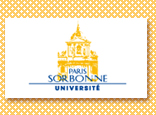| It has long been normal for painters to use high finish for the face of a portrait and loose brushwork for the background, as in Gainsboroughs portrait of Countess Howe (1764); this contrast between two brushwork techniques sets off the sitter while making the setting more suggestive |
Ben Nicholsons view of St Ives combines three modes of art:
- the forms on both sides belong to Abstract painting (even if they might be identified as curtains)
- the cups in the middle are reminiscent of Cubist technique (they are a well-known cubist theme)
- the distant seascape is figurative
It is only through the frame of abstract shapes, and with the discipline of Cubist spatial construction as a foreground, that the view makes sense: this is a tribute to the power of the St Ives landscape, revealing figurative art as a particular case of abstract painting, which is the foundation of artistic vision |
Hypermedia combines the
visual codes of several media, using them reciprocally as
transition effects: those
developed by film and video-makers (dissolves, wipes, cuts,
flash pans and the like) as well as familiar televisual effects,
such as zooms, tumbles, peel offs, wraps and pop-ups, and
the multi-screen effects derived from PC graphical user interfaces
In the early 1990s, interface effects were seen as structural metaphors; now they tend to be studied in the light of constructivism |



